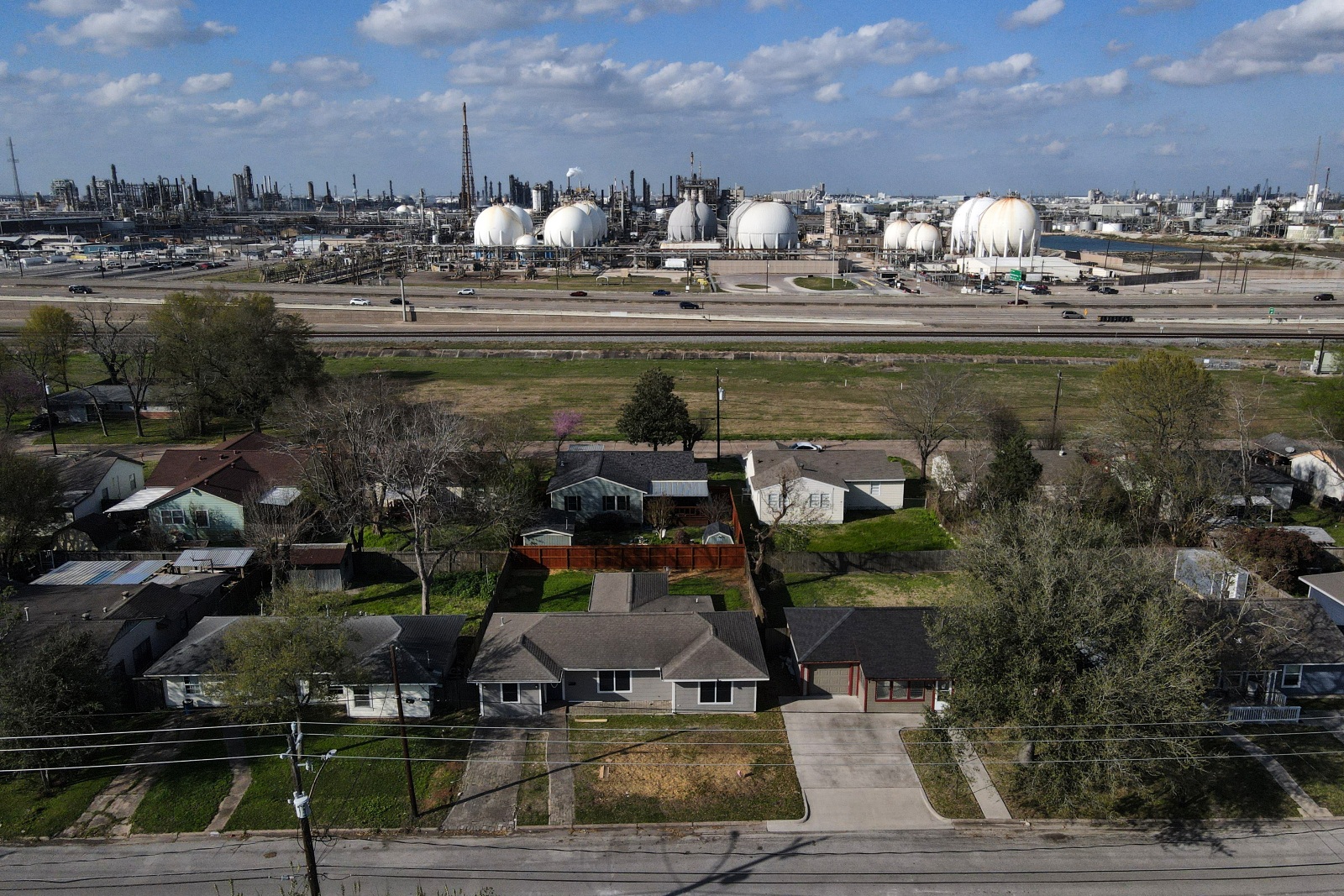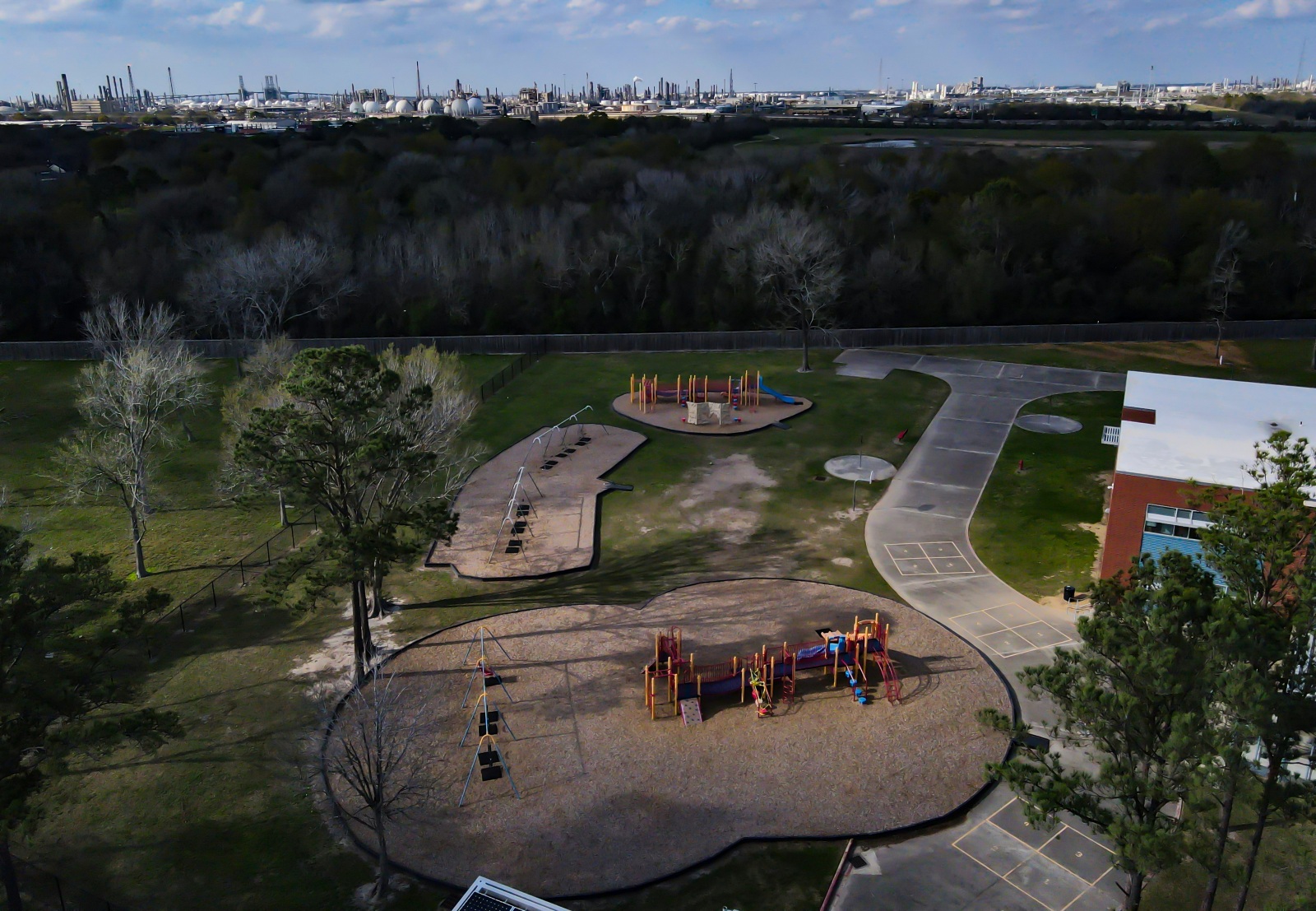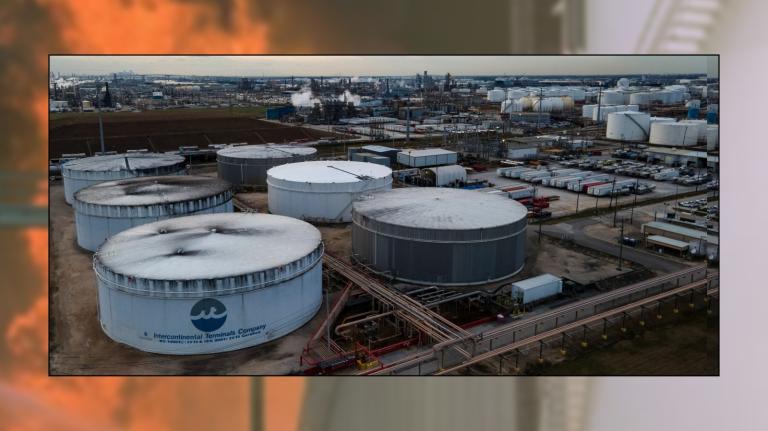This story is the second of a two-part series by Public Health Watch and The Texas Tribune. It is co-published by Grist.
A week after the massive chemical fire that spewed toxic smoke over this Houston suburb had been extinguished in March 2019, Mario Ochoa cradled his 4-year-old son and prayed the child’s cough would ease so they could both sleep. Castiel kept waking Ochoa up with “horrible and terrifying” snoring.
“It was like watching your son drown right in front of you,” Ochoa said. “[He was] gasping for air in his sleep.”
A group of massive tanks, some containing millions of gallons of highly flammable chemicals used to make plastic and gasoline, had caught fire at a chemical storage facility owned by Intercontinental Terminals Company, a Texas-based company owned by Japanese conglomerate Mitsui & Co. The fire began after a tank’s pump failed and began to leak naphtha, a highly flammable liquid.
As the fire at ITC spread from tank to tank, an ominous black plume of smoke spiraled over the Houston skyline. Ten of the tanks — each big enough to hold 3.2 million gallons of chemicals — collapsed, sending chemicals gushing into the nearby ship channel and killing birds and fish. Ash rained down on nearby neighborhoods.
Twice, city officials advised residents of Deer Park, the city closest to the fire, to shelter indoors. The first lasted 18 hours immediately after the fire broke out, and the second came three days later when air monitoring detected extremely high levels of benzene — an invisible, sweet-smelling hydrocarbon often found in crude oil and cigarettes. It’s known to cause cancer after repeated exposure and can irritate the throat and eyes. When inhaled in large quantities over a short period, benzene can affect the central nervous system and cause symptoms including dizziness, a rapid heart rate and headaches.
But what Ochoa and other residents weren’t told by federal, state and local officials at the time was that long after the fire was extinguished and life seemed to go back to normal, an invisible danger remained.
Benzene emissions spiked to abnormally high and potentially dangerous levels for more than two weeks after nearby residents were told it was safe to return to school and work, according to a Texas Tribune analysis of U.S. Environmental Protection Agency air-monitoring data. The data was collected by a mobile laboratory that roamed the area for two months after the fire erupted — one of many air quality devices deployed to monitor pollution at the time.
Almost 1,000 people swarmed to temporary mobile health clinics in Deer Park that operated for three days after the fire started, and Texas Poison Center Network records show its hotline received almost 200 calls reporting chemical exposure from the ITC fire over a more than two-week period. The most frequent symptoms were headache, throat irritation, nausea, coughing, dizziness and vomiting.
The fire had been out for days when Ochoa, a 39-year-old pipe fitter at an industrial construction company, sat awake late into the night worrying about his son, who complained that his head hurt. Ochoa grabbed a few pillows and tucked himself in a corner, hugging his son tight. He felt helpless. “I was watching him and knowing, he doesn’t even realize he’s suffocating,” he said.
He took his son to the hospital the next morning.
A few days into the crisis, officials from the EPA, the Texas Commission on Environmental Quality and Deer Park had to make a crucial decision: How much benzene in the air is too much for people to breathe? They decided they would issue public warnings only when benzene levels reached 1,000 parts per billion in the air over one minute — a level that scientists who study benzene now say was too high.
The federal, state and local officials who formed a “Unified Command” near the ITC facility after the fire erupted had to choose a threshold on the spot because there’s no accepted national standard for how much benzene in the air should be considered dangerous. They adapted it from the federal workplace standard, which allows worker exposure up to 1,000 parts per billion over an 8-hour work day.
Anita Desikan, one of the authors of a December 2022 study of the ITC fire and a senior analyst for the Center for Science and Democracy at the Union of Concerned Scientists, said the action level used during the ITC incident was “out of line with basically every other measure I’ve seen [for] benzene.”
“It’s concerning that would be the case for an emergency situation,” she said, adding that “you will see people hurt and harmed if it’s your only number for taking action.”
At a March 26 press conference — nine days after the fire started — an EPA official said the agency would “get it out to the community to take action” if it detected benzene levels above that level. “So you can trust that if it’s 1,000 parts per billion … we will let you know.”
But those warnings didn’t always come. Or, they came too late for residents to take action.
The EPA data that the Tribune used for its analysis, which was originally obtained by the nonprofit Environmental Defense Fund, shows that benzene spiked above 1,000 parts per billion on at least seven different days after the second and last shelter-in-place advisory expired — although it’s unclear from the data whether those spikes lasted for an average of 1 minute.
On six of those days, the spikes occurred in industrial areas near the ITC facility, but on March 31 — a full two weeks after the fire began — benzene spikes above 1,000 parts per billion were recorded in a residential area of Deer Park. Data from TCEQ’s stationary and handheld monitors also indicated elevated benzene concentrations near the same times and locations as the EPA’s mobile lab.
The benzene drifting through Deer Park “was a health threat to the community that went basically unshared,” said Elena Craft, a senior scientist at the Environmental Defense Fund who worked on the analysis.
“I don’t think anyone really understood the magnitude,” Craft said. “Or, they still don’t.”
When a reporter asked Deer Park Mayor Jerry Mouton about the strong smells that continued to waft through the city almost a week after the fire was extinguished, the mayor said those smells were “normal.”
“There are random times when we have smells,” said Mouton, who declined repeated requests for an interview. “We are monitoring the air continuously, and there’s nothing that’s even come close to registering any kind of action item.”
ITC said in a statement to the Tribune that there were “no longer-term public health impacts to the community” from the incident, pointing to an analysis by the Texas Department of State Health Services. The report found that health effects from benzene “were not expected to have occurred” due to the “short” amount of time high levels were detected.

The analysis did not take into account the fact that hundreds of people actually sought medical care during the incident.
Jennah Durant, a spokesperson for the EPA, said both the U.S. Centers for Disease Control and Prevention and the federal Agency for Toxic Substances and Disease Registry — a division of the U.S. Department of Health and Human Services — reviewed the action level “and had no objections.”
The city of Deer Park and ITC contracted with a company called CTEH to conduct hand-held air monitoring. In a written statement, Pablo Sanchez-Soria, a senior toxicologist at CTEH, said that using short time frames to measure benzene levels — in this case one minute in the community — help officials “take early action” to reduce human exposure.
“Based on our experience, the [1,000 parts per billion] action level for 1 minute for benzene across community areas was highly conservative,” Sanchez-Soria said. “Sufficiently protective values must be balanced against the inherent risk associated with actions such as evacuation.”
But Seth Shonkoff, an associate researcher of environmental health sciences at the University of California-Berkeley, said it’s “inappropriate to use occupational standards in a community setting” because they are designed for workers who are typically healthy adults trained to prevent chemical exposure with equipment such as respirators. Those workplace standards, he added, were a compromise between now-outdated benzene science and the economic impact on businesses.
Texas has guidelines that define what level of exposure to various chemicals could affect people’s health; for benzene, it’s 180 parts per billion in an hour. The state health agency used that number when it analyzed the potential for health problems from the ITC fire, but TCEQ spokesperson Victoria Cann said the number “does not constitute a bright line” for health impacts and is “precautionary in nature.” Emissions above that level don’t trigger any regulatory action by the agency.
A group of mostly Houston-area scientists using the most recent science on benzene exposure said that officials should have used a much more conservative threshold — 27 parts per billion in two consecutive hourly readings — and issued seven more shelter-in-place orders and 17 air quality alerts after the fire broke out. Their study, commissioned by the Houston Health Department, is awaiting peer review.
Adrian Garcia, a Harris County commissioner who represents Deer Park, said the county was “scrambling” to get current air quality data from the company or from federal and state agencies to inform their decisions.
“One of the things that I think the government tries hard to do is to be fair to everyone without being too quick to overly react,” Garcia said. “We were really trying to get to a place where we were being fair to the industry, but also transparent to the public about … whether there was still harm.”
“I’m not sure whether we really got there,” he said.
Four years later, Deer Park residents who fell ill — some of them children, elderly or otherwise at higher risk — said they sensed at the time that they were more exposed to chemicals than they were told. Many, like Ochoa, say they are still scarred by the experience.
“That kind of turmoil is haunting,” said Ochoa, who is now 43. “My soul remembers.”
Fire rages as residents fall ill — March 17-19, 2019
Deer Park resident Eddie Guevara, 19, was working a Sunday shift at a chemical plant in La Porte, a town just east of Deer Park, the day the ITC fire broke out. He was checking the windsocks mounted around the plant and jotting down the direction of the wind to help the plant workers plan the best evacuation route — just in case.
That’s when he first saw the smoke coming from the ITC tank farm.
“Anytime you see any kind of black smoke out there, it’s not good,” he said.
He glanced again at the fluttering orange windsocks. The wind was blowing the smoke toward his own home.

Guevara, who has worked in industrial plants since he was a teenager, called his dad and his brother, Anthony, to warn his family of the smoke approaching their orange brick, two-story house located just four miles from ITC.
Soon, the smoke blanketed their home. Then, their city.
Deer Park is one of a string of suburbs hugging the Houston Ship Channel, which is lined by chemical plants, refineries, smokestacks and flare towers that burn like enormous candles over a massive industrial skyline. Shell Oil Company built the first refinery in the area in 1928, and since then, generations of Deer Park residents have crossed state Highway 225 to work in the petrochemical industry.
Locals say they love their community — where block after block of single-family homes are surrounded by lush yards — because it’s quiet, safe and has great schools. And the refineries and chemical plants are a boon to their economy: The city of more than 34,000 people has a median household income of about $81,500 — higher than nearby Houston, where the median household earns $55,500.
But the risk of explosions and chemical fires always hangs over them. A 1997 explosion at Shell Oil Co. injured several workers and sent residents scurrying to shelter in their homes. A massive 2005 explosion at a BP refinery in Texas City, about 35 miles to the south next to Galveston Bay, killed 15 workers and injured nearly 200 others.
In Deer Park, the sirens that warn the public of industrial accidents are tested every week, and school children are drilled on how to shelter in place twice a year, with the assistance of “Wally Wise Guy,” a cartoon turtle who “knows it’s wise to go inside his shell” when there’s danger.
Fewer than 10 miles from where Guevara stood, firefighters rushed to the ITC facility and put their lives on the line in a war against the fire — fueled by 12.3 million gallons of highly flammable chemicals — that would burn for 64 hours straight. Bob Royall, then-assistant chief for the Harris County Fire Marshal’s Office, said it was one of the longest fires that he had battled in his almost five-decade career.
“It was a very challenging, very dangerous situation,” Royall, who is now retired, recalled. “With possible catastrophic consequences if we failed.”
Firefighters and other first responders were ordered to wear respirators if the benzene level hit 500 parts per billion over 5 minutes, according to records obtained by the Tribune.
The fire prompted Deer Park officials to advise residents to shelter in place that Sunday. But Deer Park City Manager James Stokes said air monitoring readings looked “favorable” as the fire burned off the dangerous chemicals. Meanwhile, residents, news reports and meteorologists anxiously tracked the black smoke plume that snaked over the Houston area.
Throughout the response, a plane brought in by the EPA flew above the fire and the plume, monitoring the air and providing eyes from above, while TCEQ and Harris County employees on the ground recorded benzene levels on hand-held air monitors, in addition to CTEH’s monitoring efforts for the city and company.
One Harris County official estimated that all together, more than 400 personnel took air samples throughout the response.
Despite the large monitoring effort primarily led by the feds and the state, the results were “limited,” often delayed, and not always immediately provided to local officials, according to a Harris County report. Some devices, including the EPA’s air monitoring bus, were not deployed until days after the fire broke out.
Garcia, the Harris County commissioner, said it felt like “pulling teeth” to get information about air quality. He said county officials didn’t feel they were being told everything they needed to know.
Meanwhile, an untold number of people were breathing benzene fumes without protection. In Deer Park, Guevara said his eyes burned and his heart fluttered that first evening after he went home — he said he wasn’t aware of the shelter-in-place advisory. When he stepped out to the backyard, a sanctuary where his family usually grills and gathers around a table to gossip, he said he experienced chest pains.

“I’d be out here looking at the fire and start to feel my heart going crazy,” he said.
By the next morning, the fire had spread to five additional tanks at the ITC facility, according to TCEQ and city of Deer Park records. Seven were now burning; the tanks contained naphtha, xylene, gas blendstock and pygas, a blend of chemicals that’s rich in benzene.
Deer Park city officials lifted the shelter-in-place advisory at 5:30 a.m., stating no air quality readings had exceeded “action levels.” They reopened state Highway 225, which borders the cluster of petrochemical plants and is residents’ main route to drive into Houston for work.
Despite the all-clear from city officials, Deer Park School District remained closed that Monday.
“There have been multiple reports of community members experiencing a range of symptoms from discomfort to difficulty breathing,” an email message from the school district to parents said that morning.
Ochoa, the single father, left home at the usual time Monday morning and worked a 12-hour shift outdoors in the Houston Ship Channel installing pipes. He smelled smoke and began to experience pounding headaches.
That day, his managers called him and his work team of about 10 people into the lunch room. They said the fire was nothing to worry about because the wind was blowing the danger away, but employees could go home if they were personally concerned.
Ochoa said he and his fellow workers were indeed concerned. They could smell the chemicals in the air.
But they kept working. He said they needed the money.
“I’m a single father, I had to work,” Ochoa said. “Even if I didn’t want to, I had to.”
As he installed pipes, he said his lungs ached when he took deep breaths. After two days of vomiting and “a piercing headache, behind your eyes,” he said, he drove himself to a nearby hospital Tuesday morning.
The staff checked him out and took his temperature, then told him to take ibuprofen or Tylenol for the headaches and over-the-counter nausea medication. Ochoa said he asked whether his symptoms were related to the chemical fire. The doctors said they didn’t know.
He went back to work.
With fire out, officials declare victory — March 20, 2019
By Wednesday afternoon, four days after the ITC plant ignited, federal, state and local officials hosted a press conference to announce the fire was finally out.
Mouton thanked first responders for their service.
“I’m very proud to stand here as mayor and recognize all of the officials and volunteers who waited in line to take their turn to fight for our community,” Mouton said. “Today, we are Deer Park strong.”
In a press release that day, the city assured the public that the air quality in Deer Park was not a concern. The TCEQ, meanwhile, advised “sensitive populations” — including elderly residents, pregnant people and children — to limit outdoor physical activity and told everyone to avoid any black smoke still drifting through the area.
As officials declared victory, Mario Ochoa’s mother could hardly breathe.
Mary Ann Conteras, a 58-year-old assistant director at Rosewood Funeral Home, noticed the black dust accumulating on her van’s windshield as she drove flowers to a Pasadena cemetery seven miles from the ITC facility. She then watched as the smoke plume settled above the mourning family during the funeral service. She could taste the smoke; she had the distinct sense that the smell would stick to her all-black attire and linger in her firmly pressed curly hair.
Leaving the cemetery, Contreras said she began to get headaches and feel nauseous as she drove to visit a friend in the Heights, a quiet Houston neighborhood known for its Victorian-style homes.
“I thought to myself, ‘This is not a migraine — this is totally different,’” she said. “I was gasping for air.”
She stopped along a highway median, opened her car door and threw up. Cars zoomed past her. She drove herself to an emergency room, not knowing yet that her son had gone to the hospital a day earlier for the same symptoms.
Contreras, now 62, said the doctor who saw her said her symptoms were caused by “high exposure to chemicals.” He advised her to drink lots of water and stay indoors.

An analysis of air quality data from a TCEQ’s stationary Deer Park monitor southwest of City Hall shows that benzene emissions had risen early that morning to 61 parts per billion in an hour. That was below the 1,000 parts per billion threshold set by Unified Command, but it was 12 times above the highest concentration of benzene typically found in the area. In Deer Park, benzene concentrations usually top out around 5 parts per billion in March, according to an analysis of TCEQ data by Ebrahim Eslami, an air quality research scientist at Houston Advanced Research Center.
ITC said in a statement that morning that air monitoring readings were “well below hazardous levels.” Deer Park said in a statement later that day that the city was obtaining “normal levels” of air pollutants. Harris County Judge Lina Hidalgo assured the public during a press conference that afternoon that the county was using “very conservative estimates to determine the threshold of dangerous levels of air quality.”
Yet throughout the area that day, residents from Deer Park and surrounding cities swarmed the pop-up county health clinics complaining of eye, ear, nose and throat irritation, severe headaches and trouble breathing. County health providers screened more than 900 people and referred the worst cases to local hospitals.
“We didn’t realize the amount of people that were going to actually show up,” said Michael McClendon, the director of the Office of Public Health Preparedness and Response at Harris County Public Health.
At one area hospital, a pair of medics who were helping respond to the fire were evaluated for benzene exposure that day, records show.
A second shelter-in-place when benzene ‘rears its ugly head’ — March 21-22, 2019
At the ITC tank farm, the fire was out, but a new danger emerged. The remaining chemicals in the collapsing tanks were venting into the open air.
First responders transitioned from firefighting to frantically spraying the ruptured tanks with enormous amounts of industrial firefighting foam, hoping to create a blanket to tamp down emissions. But the foam ripped apart with each big gust of wind and quickly dissolved on the hot chemicals like whipped cream melting on hot coffee.
And benzene escaped.
“After the fire fight was over, that’s when the benzene issues began to rear their ugly head,” said Royall, the former assistant chief of Harris County Fire Marshal’s Office.
Rodney Reed, an assistant chief at the Harris County Fire Marshal’s Office who worked in the county’s emergency operations center at the time, said when officials spotted spikes in benzene emissions, they called Unified Command, “and they’d [say] they had a break of the foam blanket.”
When more foam was applied, he added, the benzene levels would drop. The operation turned to tamping down benzene emissions and emptying the chemicals from the ruptured tanks.
By 4 a.m. Thursday, TCEQ inspectors found benzene emissions exceeding 1,200 parts per billion had wafted across Highway 225 and into Deer Park.
In a statement to the Tribune, the EPA said that when benzene readings topped the 1,000 parts per billion threshold in neighborhoods for at least a minute, Unified Command directed air quality inspectors to the area to take more measurements and confirm whether the concentrations were expected to linger in the area. Then, Unified Command notified local authorities.
The emissions prompted the city of Deer Park to issue a second shelter-in-place advisory. Schools canceled classes again, this time for one day.
The EPA warned in a press release that exposure could cause headaches and nausea, and then Harris County Public Health Executive Director Dr. Umair Shah encouraged residents to call the “Ask a Nurse” hotline if they experienced symptoms.
ITC spokesperson Alice Richardson choked up during a press conference after the second shelter-in-place advisory, outlining how the company and first responders were attempting to reduce the emissions.
“ITC cares,” she said, as her eyes filled with tears. “We care a lot. This is personal.”
Before noon Thursday — after a little under eight hours — the city of Deer Park lifted the shelter-in-place advisory. Robert Hemminger, Deer Park’s emergency services director at the time, told the public that benzene emissions had “significantly reduced” since that morning.
TCEQ’s stationary air monitor indicates that benzene concentrations in Deer Park had reduced to more typical levels by the late afternoon.

That day — four days after the ITC fire began — the EPA finally deployed its air monitoring bus, the rolling lab that could sample the air while it drove. The bus recorded several spikes of benzene above 1,000 parts per billion on Friday afternoon outside of the San Jacinto Battleground State Historic Site, a popular tourist destination just down the road from ITC (it was closed to the public during the fire).
While benzene levels continued to spike near the ITC facility, neighboring chemical plants were warned to shelter in place Friday afternoon — the nearby community was not.
Durant, the EPA spokesperson, characterized such spikes as “instantaneous” measurements in industrial areas that would not have prompted notification to local officials.
Meanwhile, a portion of a dike wall surrounding the tank farm collapsed, sending petrochemicals, firefighting foam and contaminated water gushing into Tucker Bayou. Fire flared up again briefly in one of the tanks, which were melting from the heat. Then another tank collapsed.
“That almost killed some firefighters,” Royall said. “It just imploded on itself and went down in a matter of seconds.”
Benzene pollution lingers as life returns to normal — March 25-29, 2019
As fire crews fought the last remnants of the fire, life in Deer Park returned to normal. By Monday — eight days after the disaster began — students returned to school, to gym class and sports activities. Kids played kickball outside on the high school football field.
“I can stand here today and tell you with assurance, that safety to the public is priority No. 1,” Mayor Mouton said that day at another press conference. “We feel safe at this time.”
In the same press conference, Adam Adams, the federal on-scene commander for the EPA, said that air monitoring results, “have been consistent — no detections [of benzene].”
In a statement, EPA spokesperson Joe Robledo clarified that benzene readings below the 1,000 parts per billion action level did not prompt notifications to the public.
But the EPA’s air monitoring bus continued detecting elevated levels of benzene as it drove through the industrial areas lining the Houston Ship Channel early that week, the Tribune’s analysis shows. That Monday afternoon, the same day as the press conference, the bus recorded three benzene spikes well above 1,000 parts per billion across the street from the ITC facility between 4 and 4:30 p.m.
On Tuesday, EPA and TCEQ officials held another press conference and said that they had “no notifications of air monitoring results” above 1,000 parts per billion. If any readings crossed that threshold, Adams said the agencies would notify local officials and the public.
Hemminger, the former Deer Park official, said in an interview that the city only warned residents if emissions exceeded the “action level” within the city’s boundaries and were expected to linger, based on weather forecasts and subsequent readings. The high readings along the highway likely wouldn’t have prompted a response, he said, because the benzene levels quickly dropped again.
“We didn’t want to alarm the public needlessly,” Hemminger said. He added that the city verified high benzene readings with multiple sources before deciding whether to tell residents to go inside.
In the Wynfield Estates neighborhood, where many of the homes are two-story red brick and shaded by big oak trees, Anthony Guevara, Eddie’s 14-year-old brother, didn’t go to school that Monday because his eyes were burning and his throat stung.
“You don’t know what you are inhaling or putting in your body,” Anthony Guevara said. “It was scary.”
The benzene continued wafting from the broken tanks: On Friday, March 29, the EPA’s air monitoring bus again recorded benzene spikes above 1,000 parts per billion, this time across the ship channel in an industrial area near Channelview — about three miles northwest of the ITC facility. No shelter-in-place advisory was issued for Channelview residents.
Luoping Zhang, a researcher and adjunct professor of toxicology at the University of California, Berkeley, said after reviewing some of the EPA’s data that she was shocked the samples were collected outdoors in the middle of the day because benzene typically breaks down quickly in the sunlight and open air. The EPA bus typically only took measurements from 9 a.m. to 5 p.m.
“Oh my god,” Zhang said after seeing the benzene readings the EPA gathered near Channelview on March 29. “That spike, to me, is really pretty high.”
Benzene drifts into Deer Park, but residents aren’t warned — March 31, 2019
On March 31, two weeks after the ITC fire erupted into flames, the EPA mobile lab was still driving around Deer Park, testing the air. Motoring down East 13th Street, the van passed brick houses, a United Methodist Church and an elementary school with a playground nestled in the shade of tall, skinny pine trees.
That Sunday morning, it drove through an invisible cloud of benzene — logging a reading above 1,000 parts per billion near San Jacinto Elementary School.
It wasn’t the first sign of trouble: Around 11:30 p.m. the night before, a neighboring industrial facility near ITC reported “high benzene detections” and said one of its workers was vomiting and being sent to a hospital, Unified Command records show. A few hours later, around 1:30 a.m. Sunday, two people working on cleanup operations at the ITC plant became ill and went home.
Climbing benzene concentrations near the facility led the EPA and TCEQ to send inspectors into Deer Park, where they found benzene was drifting through neighborhoods near where Eddie Guevara and his family of five live. TCEQ inspectors recorded three benzene spikes on handheld air monitoring devices above 1,000 parts per billion on East Boulevard the morning of March 31. One of the readings occurred two blocks south of the elementary school, in a neighborhood near the intersection of East San Augustine Street and East Boulevard.
Later that morning, EPA inspectors with handheld devices also recorded elevated benzene concentrations in the same area — including one reading above 1,000 parts per billion.
Benzene drifted for miles through the community. One of TCEQ’s stationary air monitors near Spencerview Athletic Complex, about four miles south of San Jacinto Elementary School, was recording an average hourly concentration of about 40 parts per billion at 9 a.m. — about eight times higher than the highest concentrations usually recorded at that location.
The public was not warned the entire day.
Shonkoff, the environmental health sciences researcher at UC Berkeley, called the levels of benzene recorded by the EPA’s air monitoring that day “crazy” and “very high.”
“They are striking concentrations of benzene,” Shonkoff said. “Absolutely striking.”
The Tribune’s analysis shows that benzene levels continued to spike close to, but not surpassing, 1,000 parts per billion for the rest of that Sunday morning in residential areas of Deer Park.
The air monitoring “seems like a waste” if the public wasn’t immediately told about the danger, said Craft, one of the authors of the study that concluded that more shelter-in-place advisories and air quality warnings should have been issued during the ITC disaster.
“It seemed like [the EPA] was going out and doing this monitoring between 9 a.m. and 5 p.m., and it wasn’t clear what their intention or purpose was,” Craft said. “It was a missed opportunity because [the data from the EPA’s mobile lab] could’ve been used to inform some of the public health decisions, but it doesn’t seem like it was.”

Several school administrators who worked for the district in 2019 did not recall being informed about high levels of benzene near the elementary school on March 31, Matt Lucas, director of communications for Deer Park ISD, said in an email.
More than 800 students returned for classes at the elementary school the next morning.
Residents didn’t learn of the high benzene levels until a 10 a.m. press conference on Monday, when Adams, the federal on-scene coordinator for the EPA, said there was a benzene spike on Sunday above the action level “in the community” — he didn’t say where — and added that the agency notified local officials.
But Adams said the EPA concluded that the high levels did not last long enough in the area to prompt action.
“If we get something sustained above [1,000 parts per billion], we notify the local governments to evacuate or shelter-in-place, whichever is more appropriate for the community,” Adams said.
Brent Weber, who was ITC’s “incident commander” during the fire and is now the company’s president and CEO, said during the same press conference that the company had encountered issues pumping the chemicals out of the damaged tanks over the weekend that caused an increase in benzene emissions.
Deer Park officials appeared to rely more on air monitoring readings from its hired contractor than the EPA’s. The city also released a statement that day to its residents: “We did not receive any readings above actionable levels over the weekend,” it said, citing data from CTEH, the company the city and ITC had contracted to conduct air monitoring.
CTEH is known as an industry-friendly environmental consulting firm and is frequently hired by companies during chemical emergencies.
An air quality report provided by CTEH shows that it did not not detect any concentrations of benzene above 1,000 parts per billion in Deer Park, Pasadena, Galena Park or Channelview on March 31, however, the report does not indicate at what time the readings were taken.
Stokes, the Deer Park city manager, declined to answer questions about the high levels of benzene recorded on March 31 by the EPA and TCEQ.
Eddie Guevara, who’s now 22, said officials should have been more honest with the public.
“You want to be able to trust officials and ITC representatives telling people you will be OK,” Guevara said. But, “of course they are going to downplay it.”
Uncertainty looms over benzene exposure
Guevara worries that his family won’t know the full impact of their benzene exposure for years.
“To me, it’s no joke,” he said, adding that he worries about whether the fumes he breathed could increase his risk of cancer.
While scientists have found that years of repeated exposure to benzene causes cancer, the long-term impact of being exposed to brief but high levels of benzene is less certain.
It’s notoriously challenging to determine whether cancer was caused by exposure to a specific chemical or pollutant. Some experts who study benzene said the spikes that wafted through Deer Park and the surrounding areas over that two and a half week period could increase residents’ risk of cancer, but others said it was unlikely.
“I would definitely say that [people nearby] have an increased risk,” said Zhang. But she added that it would be difficult to determine for sure.
Stephen Rappaport, a leading environmental health sciences researcher who studies chemical exposures and professor emeritus at UC Berkeley’s School of Public Health, said there is “no safe level for a carcinogen,” but added, “the evidence shows it tends to be people who have a fairly high exposure for fairly long periods of time [who develop cancer].” Studies have typically focused on workers who are exposed to the chemical over years.
The Centers for Disease Control and Prevention reviewed air monitoring data from the incident and found that the concentrations of benzene exceeded what the agency considers safe — but did not believe they were high enough to cause widespread cases of cancer.
“These concentrations are higher than we would normally consider protective,” Richard Nickle, an environmental health scientist at the CDC’s Agency for Toxic Substances and Disease Registry, said in an April 2019 email to Harris County officials.

The CDC did not recommend further health monitoring in the community. Texas’ health agency similarly concluded that although benzene is a carcinogen, exposure during the incident “is not expected to increase people’s risk of cancer.”
“Benzene is associated with cancer usually after long durations (decades) of exposure,” DSHS spokesperson Lara Anton said in a statement. “The duration of exposure related [to the ITC fire] was much shorter. … Therefore, no evaluation of cancer risk posed by exposure to benzene from this event was carried out.”
Four years later
Four years after Ochoa, his 62-year-old mother, his son and countless others were sickened by the ITC fire, federal regulators are still investigating. A final report is expected this year.
Ochoa and Contreras are two of more than 300 Houston-area residents who are suing ITC, claiming they suffered severe health impacts, including headaches, coughing up blood, respiratory infections and emotional stress during the 2019 fire — which Ochoa is fighting to forget.
“I try not to think about it, because when I do think about it, my heart feels it,” Ochoa said. There are still moments — often late into the night, when he remembers that week of the fire — when those same feelings of panic come flooding back through his mind.
“I can still feel that sorrow,” he said.
The lawsuit also asks that the company pay for residents’ future doctor visits and tests for cancer.
Some local officials now say more should’ve been done to communicate with the public when air quality worsened — and they’re working on changing their protocols.
Loren Hopkins, Chief Environmental Science Officer of Houston’s health department, said she realized that when officials issue shelter-in-place advisories and nothing else, the message to the public is confusing: “It’s all fine, up until all of the sudden it’s terrible,” she said.
“People need to be able to make their own decisions,” Hopkins said. “The data needs to be available to the public with some kind of interpretation.”
Harris County Pollution Control Executive Director Latrice Babin said in an interview that telling citizens to shelter in place is “a really hard call to make,” noting that even when high levels of chemicals are recorded, interpreting air quality testing also depends on weather conditions and location. For example, sunshine can cause chemical reactions that transform the pollution into smog, strong winds can quickly dissipate the pollutants and samples taken near highways could also detect pollution from vehicles.
In 2020, the city created its own benzene guidelines that are far lower than what was used during the ITC incident: The guidelines say officials should consider a shelter-in-place advisory if benzene levels exceed 72 parts per billion over one hour and evacuations if the level hits 200 parts per billion for an hour.
Harris County produced an analysis of what went wrong during the response. For example, the report said Harris County Pollution Control, which has a special team to respond to fires involving hazardous materials and other chemical incidents, had meager staffing and “antiquated” or out-of-service equipment during the 2019 fire.Harris County commissioners invested more than $11 million to implement the report’s recommendations. The county has created a community air response monitoring program, expanded staffing and purchased more disaster response equipment, said Dimetra Hamilton, a Harris County Pollution Control spokesperson.
Harris County is also using a $1 million grant from the American Chemistry Council to create a new guide for emergency response to chemical disasters. But a draft shared with the Tribune shows that while it identifies 22 chemicals, including benzene, that could threaten residents’ health, it does not set a specific threshold for issuing a shelter-in-place advisory.
The city of Deer Park didn’t respond to questions about whether it has changed its policies for responding to community benzene exposure.
The disaster also exposed confusion over who should be responsible for telling residents to shelter in place during a chemical release.

Rodney Reed, an assistant chief at Harris County Fire Marshal’s Office, said that each city, as well as multiple county agencies, have the authority to issue shelter-in-place advisories. But when an incident occurs at a facility like ITC that’s located in an unincorporated area of the county, deciding who has jurisdiction can be complicated. In the end, officials decided that Deer Park and ITC would lead response efforts.
The TCEQ, for its part, has beefed up its ability to test for airborne chemicals, adding new air monitors in the ship channel area since 2019 and purchasing three new air monitoring vehicles.
Still, the state renewed the chemical permit for ITC’s Deer Park facility less than a year after the fire. ITC’s operational permit is up for renewal this year and some residents have raised safety concerns about the facility ahead of the permit renewal; a public hearing will be held in May.
In 2021, TCEQ approved a rule that allows the agency to consider major explosions or fires when it decides whether to issue permits to a company — a change that agency staff pushed because of the ITC fire.
The TCEQ referred the ITC case to Attorney General Ken Paxton, whose office typically handles major industrial accidents. Paxton’s office sued the company in 2019, but the case hasn’t moved forward since 2021, according to Travis County District Court records. The attorney general’s office did not respond to requests for an interview.
ITC said in a written statement that it continues to implement “enhancements to safety, environmental integrity and emergency response capabilities” at its Deer Park location. The company said it has installed additional gas detectors and emergency shutdown valves in multiple areas of its facility.
Some residents still blame the incident for lingering health problems. Castiel, Ochoa’s now 8-year-old son, struggles with sinus infections. The chatty little boy — who told a doctor that his breathing problems felt like “bugs getting in my nose, like little tiny worms” clogging his nostrils and lungs — is now wary of playing outside at playgrounds, his father says. Instead, they spend more time indoors playing video games.
Ochoa quit his job as a pipe-fitter and found a job that doesn’t expose him to chemicals.
“People were telling me these horror stories from other refineries that were happening, people getting sick,” Ochoa said. “It’s horrifying, scary. And because I’m a single dad with a kid, I gotta find a different way.”
Now, Contreras is alert to strange odors in the air and watches for anything unusual at the nearby chemical plants — especially smoke. She has a grandson with respiratory issues and feels like it’s her duty.
“Do you have anything that you can cover up with?” she asks family and coworkers whenever she spots what might be dangerous.
“You know, to protect yourself?
Public Health Watch reporters Savanna Strott and David Leffler contributed reporting. Jade Khatib contributed data analysis.
About the data
The project is co-published with the Investigative Reporting Workshop, Public Health Watch, and the Texas Tribune.
Reporters: Erin Douglas and Alejandra Martinez, The Texas Tribune.
Copy editing: Beth Bond.
Photography: Mark Felix, Emil T. Lippe, and Liz Moskowitz.
Photo editing and web design: Pu Ying Huang.
Editors: Dave Harmon, Susan White.
Graphics: Alex Ford.
Data analysis: Caroline Covington, Jade Khatib, José Luis Martínez.



